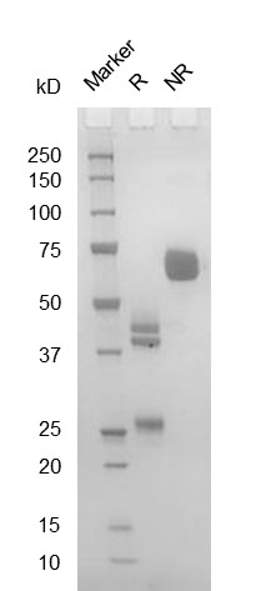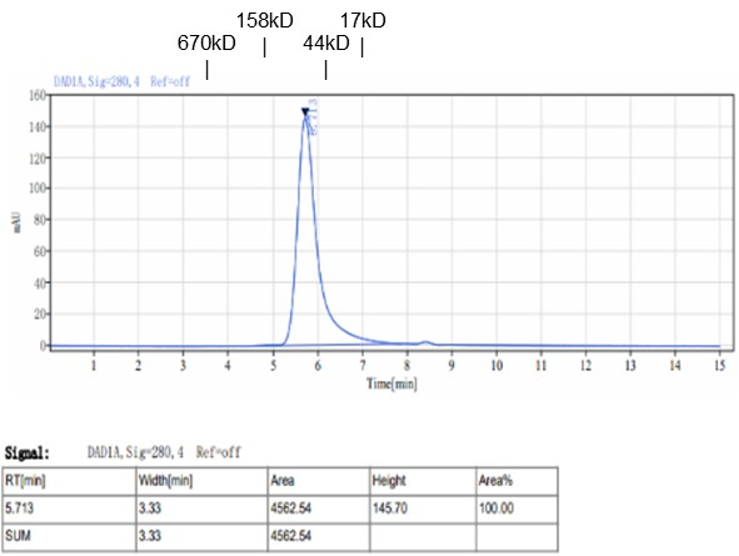mIL12a(23-215)-His_mIL12b(23-335)
Description
Interleukin-12 subunit alpha (IL12a) forms a heterodimer with interleukin-12 subunit beta (IL12b) to generate the interleukin-12 (IL12) cytokine. IL12, also known as natural killer cell stimulatory factor (NKSF) or cytotoxic lymphocyte maturation factor (CLMF), is a pleiotropic cytokine originally identified in the medium of activated human B lymphoblastoid cell lines. It is primarily produced by professional antigen-presenting cells (APCs) including B-cells, dendritic cells (DCs), macrophages and granulocytes. IL12 regulates T-cell and NK cell responses, induces interferon-gamma (IFNg) production, and synergizes with other IFNg inducers at both the transcriptional and post-transcriptional levels. Current evidence suggests that IL12 is a central mediator of the cell‑mediated immune response by influencing the development, proliferation, and activities of TH1 cells. It serves as an important link between innate resistance and adaptive immunity. Mechanistically, IL12 exerts its biological effects through a receptor composed of IL12R1 and IL12R2 subunits. The binding to this receptor leads to rapid tyrosine phosphorylation of various cellular substrates including the JAK family kinases TYK2 and JAK2. Subsequently, recruited STAT4 becomes phosphorylated and translocates into the nucleus where it regulates cytokine/growth factor responsive genes. As part of IL35 complex, IL12 plays essential roles in maintaining immune homeostasis within the liver microenvironment while also functioning as an immune-suppressive cytokine. In its role as the initiator of cell-mediated immunity, it has been suggested that IL12 holds therapeutic potential for stimulating cell-mediated immune responses against microbial pathogens, metastatic cancers, and viral infections such as AIDS. Additionally, it exhibits anti-angiogenic activity, which means it can block the formation of new blood vessels.
Product name | mIL12a(23-215)-His_mIL12b(23-335) |
Species | Mus musculus |
Expression system | HEK293 |
Buffer | PBS, pH 7.4 |
Delivery condition | Dry ice (-80°C) |
Delivery Time | 1 week if in stock; 4 weeks if production needed |
Storage condition | Store at -80°C |
Brand | BioMetas |
Applications | Allergy Research, Angiogenesis/Cardiovascular Research, Apoptosis Research, Cancer Research, Immune System, Inflammation Research, Neurobiology Research, Neuroinflammation, Stem Cells & Differentiation, Transplantation Research |
Aliases/Synonyms | IL-12, p35, p40, p70, NFSK, NKSF, CTL maturation factor (TCMF), cytotoxic lymphocyte maturation factor (CLMF), TSF, IMD28, IMD29 |
Reference | |
Note | For research use only. Not suitable for clinical or therapeutic use. |
Size | 1mg, 5mg, 10mg, 50mg, 100mg |
Brand | BioMetas |
Product type | Cytokine |
Expression system | HEK293 |
Applications | Allergy Research, Angiogenesis/Cardiovascular Research, Apoptosis Research, Cancer Research, Immune System, Inflammation Research, Neurobiology Research, Neuroinflammation, Stem Cells & Differentiation, Transplantation Research |
Contact Us for a Quote!
Data Gallery
Fig. 1.) 4-20% SDS-PAGE analysis
Recombinant protein was visualized by Coomassie Brilliant Blue R250 staining.

Fig. 2.) SEC-HPLC analysis
Column: Superdex 200 Increase 5/150 GL
Running buffer: 2xPBS, pH 7.4
